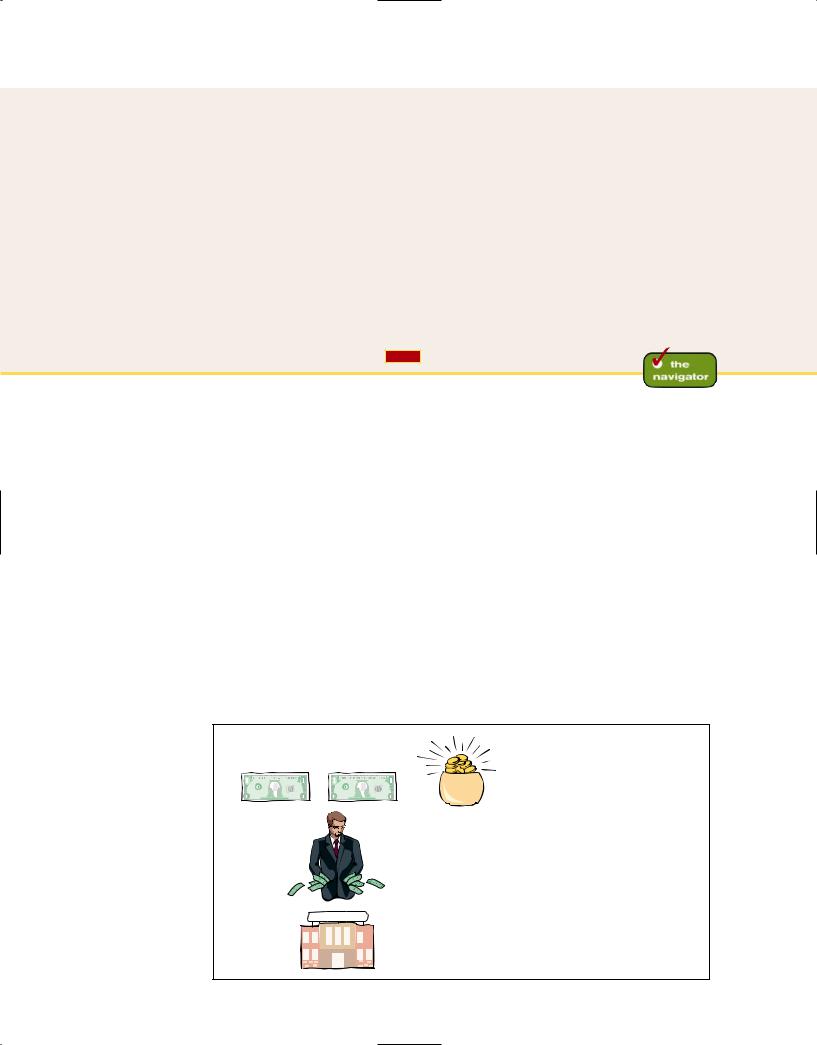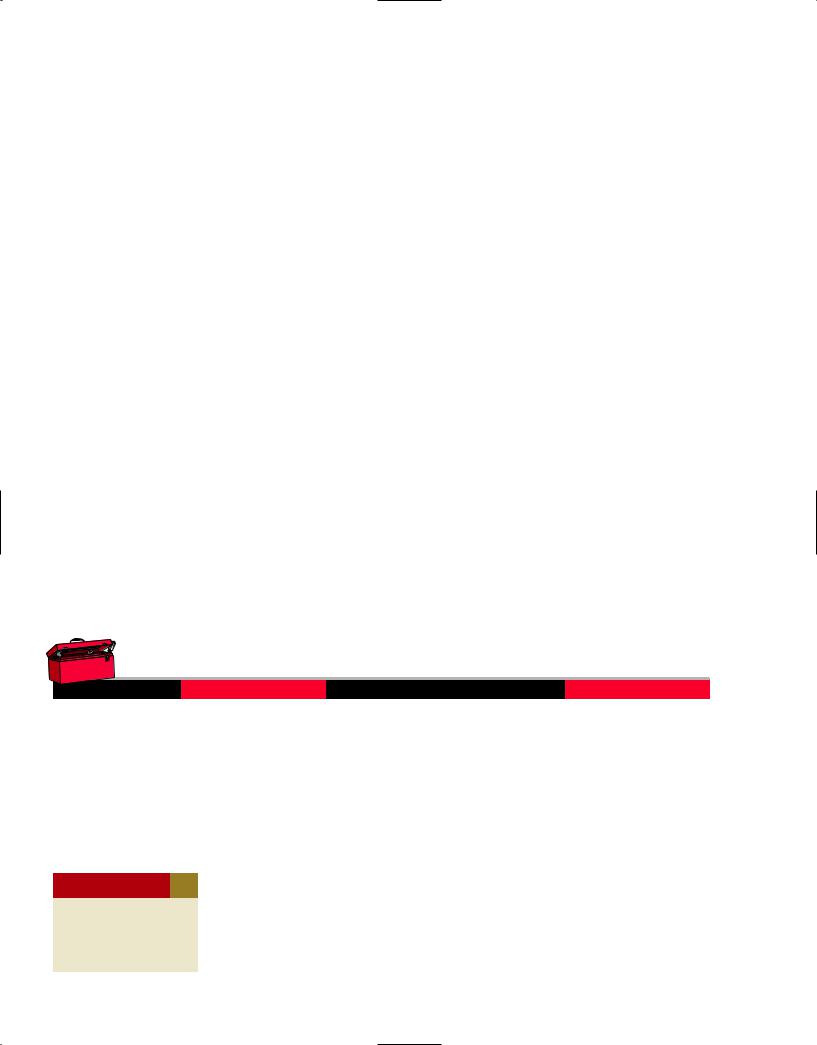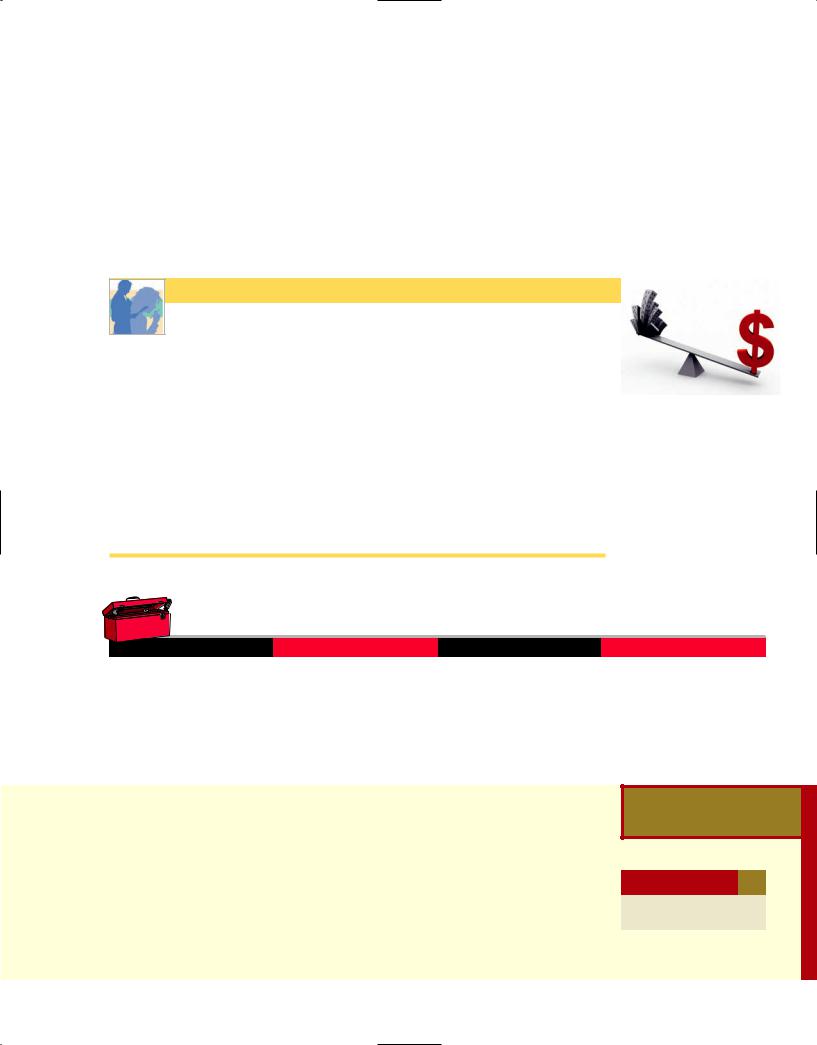
Финансовый учет. Ридер
.pdf
190
52 chapter 2 A Further Look at Financial Statements
before you go on...
ASSETS SECTION OF BALANCE SHEET
Action Plan
•Present current assets first. Current assets are cash and other resources that the company expects to convert to cash or use up within one year.
•Present current assets in the order in which the company expects to convert them into cash.
•Subtract accumulated depreciation—equipment from equipment to determine net equipment.
 Baxter Hoffman recently received the following information related to Hoffman Corporation’s December 31, 2012, balance sheet.
Baxter Hoffman recently received the following information related to Hoffman Corporation’s December 31, 2012, balance sheet.
Prepaid insurance |
$ 2,300 |
Inventory |
$3,400 |
Cash |
800 |
Accumulated depreciation— |
|
Equipment |
10,700 |
equipment |
2,700 |
|
|
Accounts receivable |
1,100 |
Prepare the assets section of Hoffman Corporation’s balance sheet.
Solution
|
|
|
|
|
|
|
|
|
|
|
|
|
|
|
HOFFMAN CORPORATION |
|
|
|
|||||
|
|
|
Balance Sheet (partial) |
|
|
|
|||||
|
|
|
December 31, 2012 |
|
|
|
|||||
|
|
|
|
|
|
|
|
||||
|
|
|
|
Assets |
|
|
|
||||
|
|
Current assets |
|
|
|
|
|
|
|
|
|
|
|
Cash |
$ 800 |
|
|
|
|
||||
|
|
Accounts receivable |
1,100 |
|
|
|
|
||||
|
|
Inventory |
3,400 |
|
|
|
|
||||
|
|
Prepaid insurance |
2,300 |
|
|
|
|
||||
|
|
|
|
|
|
|
|
|
|
|
|
|
|
Total current assets |
$ |
7,600 |
|
||||||
|
|
Equipment |
10,700 |
|
|
|
|
||||
|
|
Less: Accumulated depreciation— |
|
|
|
||||||
|
|
equipment |
|
2,700 |
|
8,000 |
|
||||
|
|
|
|
|
|
|
|
|
|
|
|
|
|
Total assets |
|
|
$15,600 |
|
|||||
|
|
|
|
|
|
|
|
|
|
|
|
|
|
|
|
|
|
|
|
|
|
|
|
Related exercise material: BE2-2, Do it! 2-1, and E2-4.
CURRENT LIABILITIES
In the liabilities and stockholders’ equity section of the balance sheet, the first grouping is current liabilities. Current liabilities are obligations that the company is to pay within the coming year or operating cycle, whichever is longer. Common examples are accounts payable, wages payable, bank loans payable, interest payable, and taxes payable. Also included as current liabilities are current maturities of long-term obligations—payments to be made within the next year on long-term obligations. In Illustration 2-2, Franklin Corporation reported five different types of current liabilities, for a total of $16,050.
Within the current liabilities section, companies usually list notes payable first, followed by accounts payable. Other items then follow in the order of their magnitude. In your homework, you should present notes payable first, followed by accounts payable.
Illustration 2-7 shows the current liabilities section adapted from the balance sheet of Marcus Corporation in a recent year.
LONG-TERM LIABILITIES
Long-term liabilities are obligations that a company expects to pay after one year. Liabilities in this category include bonds payable, mortgages payable, longterm notes payable, lease liabilities, and pension liabilities. Many companies report long-term debt maturing after one year as a single amount in the balance sheet and show the details of the debt in notes that accompany the financial

191
The Classified Balance Sheet 53
MARCUS CORPORATION
Balance Sheet (partial) (in thousands)
Current liabilities |
|
|
|
|
Notes payable |
$ |
239 |
||
Accounts payable |
|
|
24,242 |
|
Current maturities of long-term debt |
|
|
57,250 |
|
Other current liabilities |
|
|
27,477 |
|
Taxes payable |
|
|
11,215 |
|
Accrued compensation payable |
|
|
6,720 |
|
Total current liabilities |
$127,143 |
|
||
|
|
|
|
|
Illustration 2-7 Current liabilities section
statements. Others list the various types of long-term liabilities. In Illustration 2-2, Franklin Corporation reported long-term liabilities of $11,300.
Illustration 2-8 shows the long-term liabilities that The Procter & Gamble Company reported in its balance sheet in a recent year.
|
|
|
|
|
|
Illustration 2-8 Long- |
|
|
THE PROCTER & GAMBLE COMPANY |
|
|
|
|
|
|
|
|
|
term liabilities section |
|
|
|
Balance Sheet (partial) |
|
|
|
|
|
|
|
|
|
|
|
|
|
(in millions) |
|
|
|
|
|
|
|
|
|
|
|
|
Long-term liabilities |
|
|
|
|
|
|
Long-term debt |
$23,375 |
|
|
||
|
Deferred income taxes |
12,015 |
|
|
||
|
Other noncurrent liabilities |
|
5,147 |
|
|
|
|
Total long-term liabilities |
$40,537 |
|
|
||
|
|
|
|
|
|
|
STOCKHOLDERS’ EQUITY
Stockholders’ equity consists of two parts: common stock and retained earnings. Alternative Terminology
Companies record as common stock the investments of assets into the business |
Common stock is sometimes called |
by the stockholders. They record as retained earnings the income retained for |
capital stock. |
use in the business. These two parts, combined, make up stockholders’ equity |
|
on the balance sheet. In Illustration 2-2, Franklin reported common stock of |
|
$14,000 and retained earnings of $20,050. |
|
|
|
|
before you go on... |
|
Do it! |
|
|
|
The following financial statement items were taken from the financial BALANCE SHEET |
||
|
statements of Callahan Corp. |
CLASSIFICATIONS |
|
|
______ Salaries and wages payable |
______ Equipment |
|
|
______ Service revenue |
______ Accumulated depreciation— |
|
|
______ Interest payable |
equipment |
|
|
______ Goodwill |
______ Depreciation expense |
|
|
______ Short-term investments |
______ Retained earnings |
|
|
______ Mortgage payable (due in 3 years) |
______ Unearned service revenue |
|
|
______ Investment in real estate |
|
|
|
|
|
|

192
54 chapter 2 A Further Look at Financial Statements
Action Plan
•Analyze whether each financial statement item is an asset, liability, or stockholders’ equity item.
•Determine if asset and liability items are current or long-term.
Match each of the items to its proper balance sheet classification, shown below. If the item would not appear on a balance sheet, use “NA.”
Current assets (CA) |
Current liabilities (CL) |
Long-term investments (LTI) |
Long-term liabilities (LTL) |
Property, plant, and equipment (PPE) |
Stockholders’ equity (SE) |
Intangible assets (IA) |
|
Solution
|
CL |
Salaries and wages payable |
LTI |
Investment in real estate |
|||
|
NA |
|
|
Service revenue |
PPE |
Equipment |
|
|
CL |
|
|
Interest payable |
PPE |
Accumulated depreciation— |
|
|
IA |
|
|
Goodwill |
|
|
equipment |
|
CA |
|
Short-term investments |
NA |
Depreciation expense |
||
|
LTL |
|
Mortgage payable |
SE |
Retained earnings |
||
|
|
|
|
(due in 3 years) |
CL |
|
Unearned service revenue |
|
|
|
|
|
|
|
|
Related exercise material: BE2-1, Do it! 2-2, E2-1, E2-2, E2-3, E2-5 and E2-6.
Using the Financial Statements
In Chapter 1, we introduced the four financial statements. We discussed how these statements provide information about a company’s performance and financial position. In this chapter, we extend this discussion by showing you specific tools that you can use to analyze financial statements in order to make a more meaningful evaluation of a company.
RATIO ANALYSIS
Ratio analysis expresses the relationship among selected items of financial statement data. A ratio expresses the mathematical relationship between one quantity and another. For analysis of the primary financial statements, we classify ratios as follows.
Illustration 2-9 ratio classifications
Financial
Revenues |
– |
Expenses |
= |
Net |
income |
Founded in 1892
XYZ Co. 
Profitability Ratios
Measure the income or operating success of a company for a given period of time
Liquidity Ratios
Measure short-term ability of the company to pay its maturing obligations and to
meet unexpected needs for cash
Solvency Ratios
Measure the ability of the company to survive
over a long period of time

193
Using the Financial Statements 55
A single ratio by itself is not very meaningful. Accordingly, in this and the following chapters, we will use various comparisons to shed light on company performance:
1. Intracompany comparisons covering two years for the same company.
2.Industry-average comparisons based on average ratios for particular industries.
3.Intercompany comparisons based on comparisons with a competitor in the same industry.
USING THE INCOME STATEMENT
Best Buy Company generates profits for its stockholders by selling electronics. The income statement reports how successful it is at generating a profit from its sales. The income statement reports the amount earned during the period (revenues) and the costs incurred during the period (expenses). Illustration 2-10 shows a simplified income statement for Best Buy.
study objective 2
Identify and compute ratios for analyzing a company’s profitability.
BEST BUY CO., INC.
Income Statements
For the Years Ended February 28, 2009,
and March 1, 2008 (in millions)
|
|
|
2009 |
|
|
2008 |
|
|
Revenues |
|
|
|
|
|
|
|
|
Net sales and other revenue |
$45,015 |
$40,023 |
||||||
Expenses |
|
|
|
|
|
|
|
|
|
|
|
|
|
|
|
|
|
Cost of goods sold |
|
|
34,017 |
|
|
30,477 |
||
Selling, general, and |
|
|
|
|
|
|
|
|
administrative expenses and other |
|
|
9,321 |
|
|
7,324 |
||
Income tax expense |
|
|
674 |
|
|
815 |
||
|
|
|
|
|
|
|
|
|
Total expenses |
|
|
44,012 |
|
|
38,616 |
||
Net income |
|
|
|
|
|
|
||
$ |
1,003 |
$ |
1,407 |
|||||
|
|
|
|
|
|
|
|
|
|
|
|
|
|
|
|
|
|
Illustration 2-10 Best Buy’s income statement
From this income statement, we can see that Best Buy’s sales increased but net income decreased during the period. Net income decreased from $1,407 million to $1,003 million. A much smaller competitor of Best Buy is hhgregg. It operates 111 stores in 9 states and is headquartered in Indianapolis, Indiana. It reported net income of $36.5 million for the year ended March 31, 2009.
To evaluate the profitability of Best Buy, we will use ratio analysis. Profitability ratios measure the operating success of a company for a given period of time.
Earnings per Share
Earnings per share (EPS) measures the net income earned on each share of common stock. We compute EPS by dividing net income by the average number of common shares outstanding during the year. Stockholders usually think in terms of the number of shares they own or plan to buy or sell, so stating net income earned as a per share amount provides a useful perspective for determining the investment return. Advanced accounting courses present more refined techniques for calculating earnings per share.

194
56 chapter 2 A Further Look at Financial Statements
For now, a basic approach for calculating earnings per share is to divide earnings available to common stockholders by average common shares outstanding during the year. What is “earnings available to common stockholders”? It is an earnings amount calculated as net income less dividends paid on another type of stock, called preferred stock (Net income Preferred stock dividends).
By comparing earnings per share of a single company over time, one can evaluate its relative earnings performance from the perspective of a stock- holder—that is, on a per share basis. It is very important to note that comparisons of earnings per share across companies are not meaningful because of the wide variations in the numbers of shares of outstanding stock among companies.
Illustration 2-11 shows the earnings per share calculation for Best Buy in 2009 and 2008, based on the information presented below. (Note that to simplify our calculations, we assumed that any change in the number of shares for Best Buy occurred in the middle of the year.)
Illustration 2-11 Best Buy’s earnings per share
(in millions) |
2009 |
2008 |
|||
|
|
|
|
|
|
Net income |
|
$1,003 |
$1,407 |
||
Preferred stock dividends |
|
–0– |
|
–0– |
|
Shares outstanding at beginning of year |
411 |
481 |
|||
Shares outstanding at end of year |
414 |
411 |
|||
|
|
|
|
|
|
|
|
Earnings per |
|
Net Income Preferred Stock Dividends |
|
||
|
Share |
Average Common Shares Outstanding |
|
|
||
|
|
|
|
|
|
|
|
|
|
|
|
|
|
|
($ and shares in millions) |
2009 |
2008 |
|
|
|
|
|
|
|
|
|
|
|
Earnings per share |
|
$1,003 $0 $2.43 |
$1,407 $0 |
$3.15 |
|
|
|
|
(414 411)/2 |
(411 481)/2 |
|
|
|
|
|
|
|
|
|


 DECISION TOOLKIT
DECISION TOOLKIT
DECISION CHECKPOINTS |
INFO NEEDED FOR DECISION |
|
|
TOOL TO USE FOR DECISION |
HOW TO EVALUATE RESULTS |
|
How does the company’s |
Net income available to |
Earnings |
|
Net income Preferred stock dividends |
A higher measure suggests |
|
earnings performance |
common stockholders and |
per |
|
improved performance, |
||
compare with that of |
average common shares |
share |
Average common shares outstanding |
although the number is |
||
|
||||||
|
|
|||||
previous years? |
outstanding |
|
|
|
subject to manipulation. |
|
|
|
|
|
|
Values should not be |
|
|
|
|
|
|
compared across companies. |
|
|
|
|
|
|
|
study objective 3
Explain the relationship between a retained earnings statement and a statement of stockholders’ equity.
USING THE STATEMENT OF STOCKHOLDERS’ EQUITY
As discussed in Chapter 1, the retained earnings statement describes the changes in retained earnings during the year. This statement adds net income and then subtracts dividends from the beginning retained earnings to arrive at ending retained earnings.
Stockholders’ equity is comprised of two parts: retained earnings and common stock. Therefore, the stockholders’ equity of most companies is affected by factors other than just changes in retained earnings. For example, the company

195
Using the Financial Statements 57
may issue or retire shares of common stock. Most companies, therefore, use what is called a statement of stockholders’ equity, rather than a retained earnings statement, so that they can report all changes in stockholders’ equity accounts. Illustration 2-12 is a simplified statement of stockholders’ equity for Best Buy.
BEST BUY CO., INC.
Statement of Stockholders’ Equity (in millions)
|
Common |
Retained |
||||||
|
|
Stock |
|
Earnings |
||||
Balances at March 3, 2007 |
$ 478 |
|
$5,723 |
|||||
Issuance of common stock |
268 |
|
|
|
|
|||
Repurchase of common stock |
(697) |
|
|
|
|
|||
Net income |
|
|
|
|
|
1,407 |
||
Dividends |
|
|
|
|
|
(204) |
||
Other adjustments |
|
|
|
|
|
|
(2,491) |
|
|
|
|
|
|
|
|
|
|
Balances at March 1, 2008 |
|
49 |
|
4,435 |
||||
Issuance of common stock |
197 |
|
|
|
|
|||
Net income |
|
|
|
|
|
1,003 |
||
Dividends |
|
|
|
|
|
(222) |
||
Other adjustments |
|
|
|
|
|
|
(819) |
|
|
|
|
|
|
|
|
|
|
Balances at February 28, 2009 |
$ 246 |
|
$4,397 |
|||||
|
|
|
|
|
|
|
|
|
|
|
|
|
|
|
|
|
|
Illustration 2-12 Best Buy’s statement of stockholders’ equity
We can observe from this financial statement that Best Buy’s common stock decreased during the first year. Even though it had an issuance of common stock, that increase was much smaller than the decrease caused by a stock repurchase. It increased in the second year as the result of an issuance of shares. Another observation from this financial statement is that Best Buy paid dividends each year. This is a relatively recent practice for Best Buy. Prior to 2003, it did not pay dividends, even though it was profitable and could do so. You might wonder why Best Buy paid no dividends during prior years when it was profitable. In fact, in a prior year, two Best Buy stockholders discussed this question about the company’s dividend policy on an investor bulletin board. Here are excerpts:
Katwoman: “Best Buy has a nice price increase. Earnings are on the way up. But why no dividends?”
AngryCandy: “I guess they feel they can make better use of the money by investing back in the business.They still view Best Buy as a rapidly growing company and would prefer to invest in expanding the infrastructure (building new stores, advertising, etc.) than in paying out dividends. . . . If Best Buy gets to the stage of ‘stable, big company’ with little room for expansion, then I’m sure you’ll see them elect to pay out a dividend.”
AngryCandy’s response is an excellent explanation of the thought process that management goes through in deciding whether to pay a dividend. Management must evaluate what its cash needs are. If it has uses for cash that will increase the value of the company (for example, building a new, centralized warehouse), then it should retain cash in the company. However, if it has more cash than it has valuable opportunities, it should distribute its excess cash as a dividend.

196
58 chapter 2 A Further Look at Financial Statements
study objective 4
Identify and compute ratios for analyzing a company’s liquidity and solvency using a balance sheet.
USING A CLASSIFIED BALANCE SHEET
You can learn a lot about a company’s financial health by also evaluating the relationship between its various assets and liabilities. Illustration 2-13 provides a simplified balance sheet for Best Buy.
Illustration 2-13 Best Buy’s balance sheet
BEST BUY CO., INC.
Balance Sheets (in millions)
|
Assets |
|
February 28, 2009 |
March 1, 2008 |
|||||||||
|
|
|
|
|
|
|
|
|
|
|
|
|
|
|
Current assets |
|
|
|
|
|
|
|
|
|
|
|
|
|
Cash and cash equivalents |
$ |
498 |
|
$ |
1,438 |
|
||||||
|
Short-term investments |
|
|
11 |
|
|
|
|
64 |
|
|||
|
Receivables |
|
|
1,868 |
|
|
|
|
549 |
|
|||
|
Merchandise inventories |
|
|
4,753 |
|
|
|
|
4,708 |
|
|||
|
Other current assets |
|
|
1,062 |
|
|
|
|
583 |
|
|||
|
|
|
|
|
|
|
|
|
|
|
|
|
|
|
Total current assets |
|
|
8,192 |
|
|
|
|
|
7,342 |
|
||
|
|
|
|
|
|
|
|
|
|
|
|
||
Property and equipment |
|
|
6,940 |
|
|
|
|
|
5,608 |
|
|||
Less: Accumulated depreciation |
|
|
2,766 |
|
|
|
|
|
2,302 |
|
|||
|
|
|
|
|
|
|
|
|
|
|
|
|
|
|
Net property and equipment |
|
|
4,174 |
|
|
|
|
|
3,306 |
|
||
|
|
|
|
|
|
|
|
|
|
|
|
||
Other assets |
|
|
3,460 |
|
|
|
|
|
2,110 |
|
|||
|
|
|
|
|
|
|
|
|
|||||
Total assets |
$15,826 |
|
|
$12,758 |
|
||||||||
Liabilities and Stockholders’ Equity |
|
|
|
|
|
|
|
|
|
|
|
||
|
|
|
|
|
|
|
|
|
|
|
|||
|
|
|
|
|
|
|
|
|
|
|
|||
Current liabilities |
|
|
|
|
|
|
|
|
|
|
|
||
|
Accounts payable |
$ |
4,997 |
|
|
$ |
4,297 |
|
|||||
|
Accrued liabilities |
|
|
1,382 |
|
|
|
|
|
975 |
|
||
|
Accrued income taxes |
|
|
281 |
|
|
|
|
|
404 |
|
||
|
Accrued compensation payable |
|
|
459 |
|
|
|
|
|
373 |
|
||
|
Other current liabilities |
|
|
1,316 |
|
|
|
|
|
720 |
|
||
|
|
|
|
|
|
|
|
|
|
|
|
|
|
|
Total current liabilities |
|
|
8,435 |
|
|
|
|
|
6,769 |
|
||
Long-term liabilities |
|
|
|
|
|
|
|
|
|
|
|
||
|
|
|
|
|
|
|
|
|
|
|
|||
|
Long-term debt |
|
|
1,126 |
|
|
|
|
|
627 |
|
||
|
Other long-term liabilities |
|
|
1,622 |
|
|
|
|
|
878 |
|
||
|
|
|
|
|
|
|
|
|
|
|
|
|
|
|
Total long-term liabilities |
|
|
2,748 |
|
|
|
|
|
1,505 |
|
||
|
|
|
|
|
|
|
|
|
|
|
|
|
|
|
|
Total liabilities |
|
|
11,183 |
|
|
|
|
|
8,274 |
|
|
Stockholders’ equity |
|
|
|
|
|
|
|
|
|
|
|
||
|
Common stock |
|
|
246 |
|
|
|
|
|
49 |
|
||
|
Retained earnings |
|
|
4,397 |
|
|
|
|
|
4,435 |
|
||
|
|
|
|
|
|
|
|
|
|
|
|
|
|
|
Total stockholders’ equity |
|
|
4,643 |
|
|
|
|
|
4,484 |
|
||
|
|
|
|
|
|
|
|
|
|||||
Total liabilities and stockholders’ equity |
$15,826 |
|
|
$12,758 |
|
||||||||
|
|
|
|
|
|
|
|
|
|
|
|
|
|
|
|
|
|
|
|
|
|
|
|
|
|
|
|
|
|
|
|
|
|
|
|
|
|
|
|
|
|
Liquidity
Suppose you are a banker at CitiGroup considering lending money to Best Buy, or you are a sales manager at Hewlett-Packard interested in selling computers to Best Buy on credit. You would be concerned about Best Buy’s liquidity—its ability to pay obligations expected to become due within the next year or operating cycle. You would look closely at the relationship of its current assets to current liabilities.

197
Using the Financial Statements 59
WORKING CAPITAL. One measure of liquidity is working capital, which is the difference between the amounts of current assets and current liabilities:
|
Illustration 2-14 Working |
Working Capital Current Assets Current Liabilities |
capital |
When current assets exceed current liabilities, working capital is positive. When this occurs, there is greater likelihood that the company will pay its liabilities. When working capital is negative, a company might not be able to pay short-term creditors, and the company might ultimately be forced into bankruptcy. Best Buy had working capital in 2009 of $243 million ($8,192 million $8,435 million). Best Buy’s negative working capital does not necessarily mean the company has liquidity problems. It does warrant further investigation though.
CURRENT RATIO. Liquidity ratios measure the short-term ability of the company to pay its maturing obligations and to meet unexpected needs for cash. One liquidity ratio is the current ratio, computed as current assets divided by current liabilities.
The current ratio is a more dependable indicator of liquidity than working capital. Two companies with the same amount of working capital may have significantly different current ratios. Illustration 2-15 shows the 2009 and 2008 current ratios for Best Buy and for hhgregg, along with the 2009 industry average.
|
|
|
|
|
|
|
|
|
Illustration 2-15 Current |
|
|
|
|
Current Ratio |
Current Assets |
|
|
ratio |
|
|
|
|
|
Current Liabilities |
|
|
|
||
|
|
|
|
|
|
|
|
|
|
|
|
|
|
|
|
|
|
|
|
|
|
|
Best Buy |
|
|
Industry |
|
|
|
|
|
|
($ in millions) |
|
hhgregg |
Average |
|
|
|
|
|
|
|
|
|
|
|
|
|
|
2009 |
|
2008 |
2009 |
2009 |
|
|
||
|
|
$8,192 |
= .97:1 |
|
1.08:1 |
1.68:1 |
1.50:1 |
|
|
|
$8,435 |
|
|
||||||
|
|
|
|
|
|
|
|
||
|
|
|
|
|
|
|
|
|
|
|
|
|
|
|
|
|
|
|
|
What does the ratio actually mean? Best Buy’s 2009 current ratio of .97:1 means that for every dollar of current liabilities, Best Buy has 97¢ of current assets. Best Buy’s current ratio decreased in 2009. When compared to the industry average of 1.5:1, Best Buy’s liquidity seems low. It is also less than hhgregg’s.
One potential weakness of the current ratio is that it does not take into account the composition of the current assets. For example, a satisfactory current ratio does not disclose whether a portion of the current assets is tied up in slow-moving inventory. The composition of the current assets matters because a dollar of cash is more readily available to pay the bills than is a dollar of inventory. For example, suppose a company’s cash balance declined while its merchandise inventory increased substantially. If inventory increased because the company is having difficulty selling its products, then the current ratio might not fully reflect the reduction in the company’s liquidity.
Ethics Note A company that has more current assets than current liabilities can increase the ratio of current assets to current liabilities by using cash to pay off some current liabilities. This gives the appearance of being more liquid. Do you think this move is ethical?

198
60 chapter 2 A Further Look at Financial Statements
Helpful Hint Some users evaluate solvency using a ratio of liabilities divided by stockholders’ equity. The higher this “debt to equity” ratio, the lower is a company’s solvency.
Accounting Across the Organization
Can a Company Be Too Liquid?
There actually is a point where a company can be too liquid—that is, it can have too much working capital. While it is important to be liquid enough to be able to pay short-term bills as they come due, a company does not want to tie up its cash in extra inventory or receivables that are not earning the company money.
By one estimate from the REL Consultancy Group, the thousand largest U.S. companies have on their books cumulative excess working capital of $764 billion. Based on this figure, companies could have reduced debt by 36% or increased net income by 9%. Given that managers throughout a company are interested in improving profitability, it is clear that they should have an eye toward managing working capital. They need to aim for a “Goldilocks solution”—not too much, not too little, but just right.
Source: K. Richardson, “Companies Fall Behind in Cash Management,” Wall Street Journal (June 19, 2007).
?What can various company managers do to ensure that working capital is managed efficiently to maximize net income? (See page 96.)
Solvency
Now suppose that instead of being a short-term creditor, you are interested in either buying Best Buy’s stock or extending the company a long-term loan. Longterm creditors and stockholders are interested in a company’s solvency—its ability to pay interest as it comes due and to repay the balance of a debt due at its maturity. Solvency ratios measure the ability of the company to survive over a long period of time.
DEBT TO TOTAL ASSETS RATIO. The debt to total assets ratio is one source of information about long-term debt-paying ability. It measures the percentage of total financing provided by creditors rather than stockholders. Debt financing is more risky than equity financing because debt must be repaid at specific points in time, whether the company is performing well or not. Thus, the higher the percentage of debt financing, the riskier the company.
We compute the debt to total assets ratio as total debt (both current and long-term liabilities) divided by total assets. The higher the percentage of total liabilities (debt) to total assets, the greater the risk that the company may be unable to pay its debts as they come due. Illustration 2-16 shows the debt to total assets ratios for Best Buy and hhgregg, along with the 2009 industry average.
Illustration 2-16 Debt |
|
|
|
|
|
|
|
|
|
|
to total assets ratio |
|
|
|
Debt to Total Assets Ratio Total Liabilities |
|
|
||||
|
|
|
|
|
|
|||||
|
|
|
|
|
|
|
Total Assets |
|
|
|
|
|
|
|
|
|
|
|
|
|
|
|
|
|
|
Best Buy |
|
|
|
Industry |
|
|
|
|
|
|
($ in millions) |
|
hhgregg |
|
Average |
|
|
|
|
|
|
|
|
|
|
|
|
|
|
|
2009 |
|
2008 |
2009 |
|
2009 |
|
||
|
|
|
$11,183 |
= 71% |
|
65% |
64% |
|
57% |
|
|
|
|
|
|||||||
|
|
$15,826 |
|
|
|
|
|
|
||
|
|
|
|
|
|
|
|
|
|
|
|
|
|
|
|
|
|
|
|
|
|
The 2009 ratio of 71% means that every dollar of assets was financed by 71 cents of debt. Best Buy’s ratio exceeds the industry average of 57% and is higher than hhgregg’s ratio of 64%. The higher the ratio, the more reliant the company is

199
Using the Financial Statements 61
on debt financing. This means the company has a lower equity “buffer” available to creditors if the company becomes insolvent. Thus, from the creditors’ point of view, a high ratio of debt to total assets is undesirable. Best Buy’s solvency appears lower than hhgregg’s and lower than the average company in the industry.
The adequacy of this ratio is often judged in the light of the company’s earnings. Generally, companies with relatively stable earnings, such as public utilities, can support higher debt to total assets ratios than can cyclical companies with widely fluctuating earnings, such as many high-tech companies. In later chapters, you will learn additional ways to evaluate solvency.
Investor Insight
When Debt Is Good
Debt financing differs greatly across industries and companies. Here are some debt to total assets ratios for selected companies in a recent year:
|
Debt to Total |
|
|
Assets Ratio |
|
American Pharmaceutical Partners |
19% |
|
Callaway Golf Company |
20% |
|
Microsoft |
21% |
|
Sears Holdings Corporation |
73% |
|
Eastman Kodak Company |
78% |
|
General Motors Corporation |
94% |
|
|
|
|
?Discuss the difference in the debt to total assets ratio of Microsoft and General Motors. (See page 96.)


 DECISION TOOLKIT
DECISION TOOLKIT
DECISION CHECKPOINTS |
INFO NEEDED FOR DECISION |
TOOL TO USE FOR DECISION |
HOW TO EVALUATE RESULTS |
||
Can the company meet its |
Current assets and current |
Current ratio |
Current assets |
Higher ratio suggests favorable |
|
near-term obligations? |
liabilities |
Current liabilities |
liquidity. |
||
|
|
|
|
|
|
Can the company meet its |
Total debt and total assets |
Debt to total |
Total liabilities |
Lower value suggests favorable |
|
long-term obligations? |
|
assets ratio |
|
Total assets |
solvency. |
In the statement of cash flows, cash provided by operating activities is intended to indicate the cash-generating capability of the company. Analysts have noted, however, that cash provided by operating activities fails to take into account that a company must invest in new property, plant, and equipment (capital expenditures) just to maintain its current level of operations. Companies also must at least maintain dividends at current levels to satisfy investors. A measurement to provide additional insight regarding a company’s cash-generating ability is free cash flow. Free cash flow describes the cash remaining from operating activities after adjusting for capital expenditures and dividends paid.
Consider the following example: Suppose that MPC produced and sold 10,000 personal computers this year. It reported $100,000 cash provided by operating
KEEPING AN EYE
ON CASH
study objective 5
Use the statement of cash flows to evaluate solvency.
